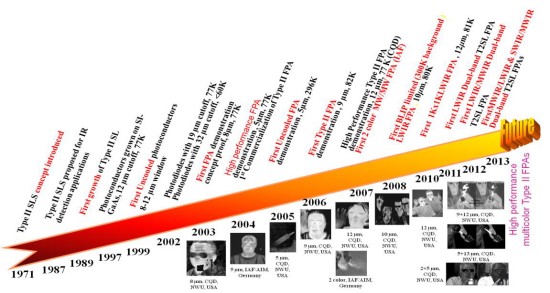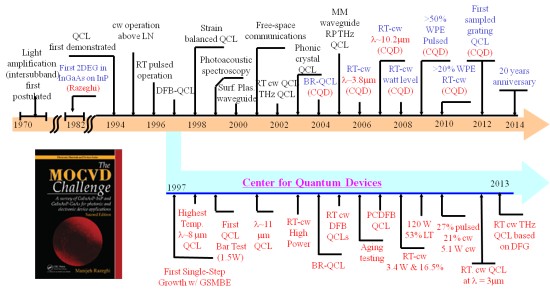
Plenary Lecture
From Terahertz to Deep UV, Science, Technology, and application of Quantum Devices

Professor Manijeh Razeghi
Center for Quantum Devices
Department of Electrical Engineering and Computer Science
Northwestern University
Evanston, IL, USA
E-mail: razeghi@eecs.northwestern.edu
Abstract: Exploration is certainly part of the human being character, and it has been a significant part of human history. It stated by land exploration; but human found a new one in space. Space, as a new frontier for exploration, has always been a driver of the modern human. Electromagnetic waves have been mainly used in space exploration from the very first day, even before human can fly. Once in space the information of the universe appears to man or his spacecraft in the form of electromagnetic radiation: light. Using light, one can see deep space and discover new objects and cosmic events. We can also look down to the earth and monitor the weather, gather information about natural resources, monitor the activity of other humans, and etc. For each of this application different types of light, such as terahertz (THz), infrared (IR), and ultraviolet (UV), are needed. For example, when looking at the earth, we can observe the complex and evolving weather patterns but for this we need the right detectors. The thermal or infrared images recorded by sensors called scanning radiometers enable a trained analyst to determine cloud heights and types, to calculate land and surface water temperatures, and to locate ocean surface features. Weather observation is typically made via different 'channels' of the infrared: 3.9 μm – 7.3 μm (Water Vapor), 8.7 μm, – 13.4 μm (Thermal imaging). In space, there are many regions which are hidden from optical telescopes because they are embedded in dense regions of gas and dust. However, infrared radiation, having wavelengths which are much longer than visible light, can pass through dusty regions of space without being scattered. This means that we can study objects hidden by gas and dust in the infrared, which we cannot see in visible light, such as the center of our galaxy and regions of newly forming stars.

Figure 1. Historical development of Type-II superlattice photodetectors and imaging.
Depending almost exclusively on imaging capabilities, "spy satellites" have been orbiting by the hundreds (by several countries) to gather military intelligence or information about terrorist activities. Visible, Near-Infrared, Thermal Infrared (MWIR and LWIR), and Radar sensors are applied to gathering information about ground targets and activities of national security significance. Infrared imaging is also the main tool for the Missile Warning Satellites (MWS). The photodetectors and light emitting diodes (LED) operating in UV spectrum are of particular interest for wide range of space applications. Young stars and stellar remnants (white dwarfs) tend to emit substantial quantity of their radiation in the UV portion of the spectrum. Whereas, many of the important atomic resonance lines are in the UV or Doppler shifted into the UV. This makes UV astronomy ideal for studying the origins and elemental makeup of the universe. Furthermore, the atmospheric ozone layer absorbs nearly 100 percent of the energy in solar-blind spectrum. The UV photodetectors and UV LEDs operating in this spectral window would allow space communication, which would be secure from earth.

Figure 2. Historical development of quantum cascade lasers.
Human eye, as the first electromagnetic wave receiver, helped us to discover the universe. But its detection spectrum is extremely limited compare to the whole electromagnetic spectrum. Therefore, the search for alternative ways of detecting electromagnetic waves has been going on from a long time ago. Starting from second half of 20th century, semiconductors became the main platform to realize compact, low-power light detectors and emitters in different regimes from terahertz to deep UV. After years of considerable effort to bring these technologies to maturity, we now see the results of this formidable new science in almost every electronic and photonic device that we encounter. Among the most successful triumphs are the type-II superlattice-based photodetectors (Figure 1) and quantum cascade lasers (Figure 2) for detection and emission from terahertz to short infrared as well as III-Nitride-based materials (Figure 3) for UV detection and emission—these technologies have demonstrated the beauty of turning fundamental concepts into practical devices, thanks to advanced growth technologies. This enables us to design and realize compact devices capable for fulfilling the space applications. Here, we present our research results about these three technologies and their potential applications for space exploration.

Figure 3. Scanning electron micrographs of the thick AlN growth (left)a side-view of the regrowth with yellow lines delineating the boundary between the AlN growth and the silicon substrate; and, (middle & right) an inclined view of the surface after flip-chip bonding and substrate removal.
Brief Biography of the Speaker: Manijeh Razeghi received the Doctorat d'État es Sciences Physiques from the Université de Paris, France, in 1980.
After heading the Exploratory Materials Lab at Thomson-CSF (France), she joined Northwestern University, Evanston, IL, as a Walter P. Murphy Professor and Director of the Center for Quantum Devices in Fall 1991, where she created the undergraduate and graduate program in solid-state engineering. She is one of the leading scientists in the field of semiconductor science and technology, pioneering in the development and implementation of major modern epitaxial techniques such as MOCVD, VPE, gas MBE, and MOMBE for the growth of entire compositional ranges of III-V compound semiconductors. She is on the editorial board of many journals such as Journal of Nanotechnology, and Journal of Nanoscience and Nanotechnology, an Associate Editor of Opto-Electronics Review. She is on the International Advisory Board for the Polish Committee of Science, and is an Adjunct Professor at the College of Optical Sciences of the University of Arizona, Tucson, AZ. She has authored or co-authored more than 1000 papers, more than 30 book chapters, and fifteen books, including the textbooks Technology of Quantum Devices (Springer Science+Business Media, Inc., New York, NY U.S.A. 2010) and Fundamentals of Solid State Engineering, 3rd Edition (Springer Science+Business Media, Inc., New York, NY U.S.A. 2009). Two of her books, MOCVD Challenge Vol. 1 (IOP Publishing Ltd., Bristol, U.K., 1989) and MOCVD Challenge Vol. 2 (IOP Publishing Ltd., Bristol, U.K., 1995), discuss some of her pioneering work in InP-GaInAsP and GaAs-GaInAsP based systems. The MOCVD Challenge, 2nd Edition (Taylor & Francis/CRC Press, 2010) represents the combined updated version of Volumes 1 and 2. She holds 50 U.S. patents and has given more than 1000 invited and plenary talks. Her current research interest is in nanoscale optoelectronic quantum devices.
Dr. Razeghi is a Fellow of MRS, IOP, IEEE, APS, SPIE, OSA, Fellow and Life Member of Society of Women Engineers (SWE), Fellow of the International Engineering Consortium (IEC), and a member of the Electrochemical Society, ACS, AAAS, and the French Academy of Sciences and Technology. She received the IBM Europe Science and Technology Prize in 1987, the Achievement Award from the SWE in 1995, the R.F. Bunshah Award in 2004, and many best paper awards.